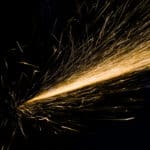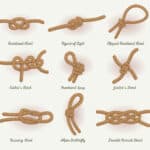Lost in the wilderness, your top priority is to signal for help effectively. Personal locator beacons and satellite messengers can mean the difference between being found quickly or not at all.
This article will guide you through crafting clear distress signals with tools ranging from high-tech gadgets to basic environmental objects. Stay calm, and let’s learn survival signaling together!
Table of Contents
Key Takeaways
- Always carry tools like signal mirrors, whistles, and Personal Locator Beacons for sending distress signals in the wilderness. A signal mirror reflects sunlight to grab attention, while a whistle can emit loud sounds far-reaching through forests.
- Use visual distress signals such as arranging rocks or logs into an SOS pattern, waving brightly colored flags, or creating smoke from a fire. These methods increase visibility to rescuers, especially if you are stranded in vast open spaces or dense woods.
- Audible signals are equally important; use three gunshots or bangs on wood in succession, as this is universally understood as a call for help. Keep repeating these specific rhythms to alert search and rescue teams even without visual contact.
- Understand how advanced technology aids survival; personal locator beacons send out emergency alerts with your location via satellite network and handheld satellite messengers allow for two-way communication even when off-grid.
- Practice using all signaling devices before venturing into the wilderness. Knowing how to create both visible and audible alerts swiftly can significantly speed up your rescue process should you find yourself in an emergency situation.
Understanding Survival Signaling
Understanding survival signaling begins with recognizing the critical role it plays in staying safe outdoors. Knowing how to alert search and rescue teams can be a lifesaver if you find yourself lost or in danger.
Imagine being stranded without this knowledge; your chances of quick rescue diminish greatly. Visual signals like signal fires, brightly colored clothing, or signal mirrors catch rescuers’ eyes from afar.
Audio signals amplify your presence through whistles or gunshots echoing across a vast wilderness.
Learn different ways to send clear messages for help using items from a standard survival kit or natural resources around you. A signal mirror can reflect sunlight over great distances, making line-of-sight communications possible during the day.
At night, strobe lights or flashlights tap into Morse code, an international distress signal recognized worldwide. To increase your odds of being found, mastering these skills sharpens your ability to communicate effectively when every moment counts.
Moving beyond theory into practical application teaches us that acquiring survival signaling tools enhances our preparedness for unforeseen circumstances in the wilds of nature. Equip yourself not just with gadgets but also skillful techniques next time you venture out—your life may depend on it.
Now that we’ve scratched the surface on understanding signaling tactics let’s explore “Different Types of Distress Signals.”
Different Types of Distress Signals

When lost or facing danger in the wilderness, your survival may hinge on effectively communicating distress. From sounds that pierce the silence to visuals that catch a rescuer’s eye, each type of signal serves as a lifeline, beckoning assistance from afar.
Audible Signals
Using audible signals can be a game-changer in wilderness survival. A sharp whistle, three gunshots fired in succession, or even banging rocks together can alert rescuers to your location.
These sounds carry far and wide through the forest, bouncing off trees and traveling farther than the human voice. Repeat these noises in sets of three—a universally recognized signal for help—to increase your chances of being heard by someone who can come to your aid.
Employing radio equipment requires knowledge of specific guidelines to maximize effectiveness while conserving battery power. Antenna placement is critical; ensure it’s high enough to send a distress call that reaches as far as possible.
Rescuers are trained to recognize audio cues like SOS sent in Morse code (· · · — — — · · ·), which you can tap out on metallic objects if radios fail. Keep signaling tools such as whistles close at hand within your survival kit; they could save your life when visibility is poor or night has fallen.
Visible Signals
Visible signals are a crucial method for attracting help in the wilderness, especially from rescuers who may be searching by air or across long distances. High up in a plane or helicopter, pilots can more readily spot signals on open ground.
Catch their attention with large signs made from materials at hand; arrange rocks, logs, or even snow to form SOS patterns that stand out against the natural environment.
Another effective technique involves using shiny objects like signal mirrors to reflect sunlight toward searchers, sending bright flashes that can be seen for miles. This is where your survival kit tools come into play; items such as flares and flashlights become vital during low visibility conditions such as dusk or dawn.
Signal fires arranged in specific patterns also boost your chances of being seen. Remember that unique shapes like triangles can signify distress and capture attention more than random fire locations would.
Always keep safety in mind and ensure you don’t inadvertently start a wildfire while trying to summon aid.
SOS Signals
Sending an SOS signal is one of the most universally recognized calls for help. You can create this critical message in a pinch using any method that produces light or sound. For example, you can blink a flashlight in groups of three short bursts followed by three longer ones and then another set of three short bursts to relay your distress call visually.
If light isn’t an option, make some noise instead; banging on a metal object or clapping rocks together with the same pattern—three quick sounds, followed by three slower, louder ones and then another set of faster beats—can alert rescuers within earshot.
Keep repeating these signals at regular intervals to maximize the chances that people will notice them nearby or even far off. Whether stranded in vast woodlands or adrift at sea, crafting clear SOS messages is essential for scouting rescue teams pinpointing your location.
Techniques for Signaling in the Wilderness
Mastering the art of signaling in the wilderness can mean the difference between being found or remaining lost; delve into these life-saving methods to ensure you’re seen and heard should an emergency arise.
Using a Signal Fire
Signal fires have been a classic way to seek help in the wild. They grab the attention of rescuers by producing smoke and light that can be seen for miles.
Using a Signal Mirror
Using a signal mirror is a powerful way to communicate your location when you’re lost or in distress. A well-used signal mirror can send a visible alert for up to 10 miles, making it an essential item in your outdoor safety kit.
- Choose a signal mirror with a sighting lens for accuracy. This feature will help you direct the reflective sunlight precisely where you need it.
- Practice in an open area before heading out on your adventure. Proper technique increases the chances of being spotted by rescuers.
- Hold the mirror close to your face, aiming the reflected light toward your target. Use one hand to steady the mirror and the other to form a V-sight with your fingers.
- Keep your target within the V-sight formed by your fingers. This ensures that the light flash from your signal mirror moves directly toward the intended receiver, whether it’s a plane overhead or rescuers on the horizon.
- Sweep the horizon if you don’t have an exact target. Rapid left-to-right movements create flashes that can catch attention from various angles.
- Signal in bursts of three if possible, as this is internationally recognized as a sign of distress.
- Stay patient and persistent even if immediate rescue seems unlikely. Rescuers may be scanning large areas and could notice your signals at any moment.
- Protect your eyes from sun glare while using the tool. Direct sunlight can cause temporary vision impairment, so taking precautions is important for safe signaling.
Using a Personal Locator Beacon or Satellite Messenger Device
Moving on from reflecting light signals, let’s turn our attention to the advanced technology of personal locator beacons and satellite messenger devices. These tools are critical additions to your survival kit and can mean the difference between being found or remaining lost.
- Personal Locator Beacon (PLB): A PLB is a compact device designed for emergencies. Once activated, it sends out a distress signal with your exact GPS coordinates to the closest search-and-rescue team.
- Activation: Deploying a PLB involves flipping a switch or lifting an antenna, depending on the model.
- Distress Signal: This beacon transmits a powerful SOS message via government-owned satellites that are part of the international COSPAS-SARSAT network.
- Global Coverage: Unlike cell phones, PLBs work anywhere in the world, providing peace of mind during remote expeditions.
- Battery Life: Most have long battery lives that last years in standby mode, ensuring they’re ready when you need them.
- Satellite Messenger Device: For those seeking more communication options, satellite messengers like InReach offer two-way text messaging ability along with distress signal capabilities.
- Text Communication: Send and receive messages with friends, family, or rescue services even when you’re off-grid.
- GPS Tracking: Share your journey by allowing others to track your location in real-time through satellite links.
- Check-In Feature: Regularly send check-in messages to reassure loved ones of your safety without triggering an alarm.
How to Make Distress Signals
Crafting an effective distress signal is vital in emergencies, and with the right techniques, you can greatly improve your chances of rescue. Dive into our guidance on innovating signals that grab attention when every second counts.
Creating a Fire Signal
Creating a fire signal is one of the most effective ways to catch the attention of rescuers when you’re stranded in the wilderness. It’s visible from far distances and can indicate your location day or night.
- Locate a spacious, open area: Find a clearing where trees and other obstacles won’t block the view from above.
- Clear the ground: Remove any debris or flammable materials around your intended fire site to prevent the flames’ accidental spread.
- Gather materials: Collect dry wood, leaves, and anything that can burn quickly and brightly. Make sure you have enough to keep the fire going for hours.
- Build three fires in a triangle: This is an internationally recognized distress signal. The triangle shape alerts rescue teams that someone needs help.
- Pile on green vegetation: Once your fires are established, add green plants or branches to produce smoke, which is easier to see against a clear sky during daylight.
- Keep it controlled: Monitor your fires at all times. A survival situation does not excuse reckless fire handling that could lead to forest damage.
- Maintain fuel supply: Store extra wood nearby so you can feed your signal fires as needed without having to search for more resources.
Using Flags for SOS
Flags stand out as a visual lifeline when you’re lost or in trouble in the wilderness. Brightly colored flags can be your call for assistance, signaling that you need help without making a sound.
- Choose the right color: Select flags that are bright and highly visible against the natural background. Orange, red, or even blue work well to catch the eye of potential rescuers.
- Keep it large: Your flag should be big enough to be seen from a distance. If you don’t have a pre-made signal flag, improvise with pieces of fabric or clothing.
- Use the SOS pattern: Wave your flag in sets of three to represent the international distress signal, SOS. Three short waves, followed by three longer ones, then another three short waves is the recognized pattern for help.
- Find an open space: Position yourself in a clearing or on high ground where trees won’t obstruct your signal. Visibility is crucial for signaling success.
- Attach your flag to something long: Use a stick or branch to extend your flag’s reach and make waves more noticeable from afar.
- Practice proper timing: Signal during daylight hours when visibility is at its peak and avoid wasting energy during times of low visibility, such as heavy fog or rain.
- Combine with other signals: If possible, use your flag in conjunction with audible signals like whistles or shouts to increase the chances of being noticed.
Using Audible Signals with Hardwood Logs
Using audible signals can be a vital way to attract help if you’re lost in the wilderness. Hardwood logs serve as excellent instruments for creating noise that can carry over long distances. Here’s how to use them effectively:
- Find a hollow hardwood log; its natural shape amplifies the sound when struck.
- Use a sturdy stick or the back of your survival knife to bang on the log, mimicking the rhythm of an SOS signal – three short, three long, three short taps.
- Space out your tapping sequences with pauses in between; this ensures that anyone listening can recognize it as a deliberate distress signal.
- Strike the log with consistent force. This creates a steady and loud beat that can alert nearby rescuers or other hikers.
- Aim for lower tones by beating closer to the center of the log’s hollow section, which resonates better than higher-pitched sounds for ground-based listeners.
- Combine this method with visual signals like fire or flags if possible since audible signals alone may not catch the attention of aircraft effectively.
Signaling Tools and Technologies
In the quest for survival, innovative tools and technologies have emerged to enhance your ability to signal for help efficiently. From devices that connect directly with search and rescue satellites to simple yet effective reflective surfaces, each offers a lifeline when traditional methods may fall short.
Handheld Satellite Messenger Device
Handheld satellite messenger devices are a game-changer for wilderness adventurers and those in remote areas needing to signal for help. These compact gadgets harness the power of global satellite networks, allowing users to send their exact GPS location to local search-and-rescue teams with the push of a button.
This technology ensures that even when miles away from cell service or in challenging terrain, you’re never out of reach of life-saving assistance.
Equipped with robust features, these devices can also allow two-way messaging, provide weather updates, and enable you to check in safely with friends and family back home. Their durability and ease of use make them an essential tool for anyone venturing into the great outdoors—whether you’re an experienced Eagle Scout navigating through the Wepawaug Valley District or a fan of survival techniques like Les Stroud (‘Survivorman’).
With a handheld satellite messenger device in your pack, peace of mind is at your fingertips as you explore our planet’s most untouched corners.
Personal Locator Beacon
Personal Locator Beacons are crucial for adventurers trekking into remote areas. They function like a panic button, sending out an emergency distress signal with your precise GPS location to the nearest search-and-rescue teams.
Unlike cell phones that may lose service, PLBs work in the most isolated regions, ensuring help is just a button press away.
These small yet powerful devices tap into the Cospas-Sarsat international satellite system. This network provides rapid alert and location information to local rescue services, assisting them in pinpointing your exact position quickly and efficiently.
Moving on from individual safety gadgets like the Personal Locator Beacon brings us to other signaling tools such as the Signal Mirror, which can further enhance your chances of being spotted by rescuers.
Signal Mirror
While a Personal Locator Beacon is great for electronic distress signaling, knowing how to use a signal mirror can be just as crucial in an emergency. These mirrors are not just any reflective surface; they are designed specifically for survival situations.
They shine bright flashes of sunlight over long distances, making them ideal for catching the eye of rescue teams or passing aircraft.
A signal mirror is an essential piece of equipment for your wilderness survival kit, especially in sunny conditions and open areas where visibility is high. You angle the mirror toward the sun to reflect light and create noticeable signals that can be seen from far away, even several miles in clear weather.
This simple yet effective tool has helped countless adventurers signal for help without relying on batteries or technology – it harnesses the power of natural light to deliver a lifeline.
Understanding Response Signals
Recognizing the signs that help is on the way is crucial in a survival situation. Once you’ve sent out distress signals, it’s essential to know what to look for in return. Rescuers might communicate with flashes of light, similar to how you’d use a signal mirror during daylight.
These could be from flashlights, heliographs, or other reflective devices aimed at letting you know someone has seen your SOS.
Listen carefully for response signals as well; radio direction finding may lead rescuers to your location if you’re using a radio transmitter. Even without gadgets, loud and distinct noises like helicopter rotors or rescue vehicles can signify that aid is nearby.
Keep an ear out for these audio cues—they can give you vital information about the direction and distance of approaching help. Stay alert and ready to respond if necessary, establishing two-way communication with your rescuers can expedite your rescue operation considerably.
Conclusion
Survival signaling in the wilderness can save your life. Master the techniques and understand what tools are at your disposal. Bright flares, loud sounds, and high-tech devices could be your lifeline to safety.
Remember to signal clearly and repeatedly for help. Practice these essential skills because they make all the difference when every second counts.
Can Distress Signals Be Used to Signal for Medical Help in the Wilderness?
In the wilderness, distress signals can be used to signal for medical help when treating common injuries outdoors. Building a large fire, using a whistle, or creating a signal with rocks or branches can alert others to your location. It’s crucial to have a plan in case of emergencies while exploring remote areas.
FAQs
What are some effective ways to signal for help in the wilderness?
To signal for help, you can use a flashlight to send an SOS message, create a large smoke signal by making a tree torch, or use mirrors during daylight to reflect sunlight and catch rescuers’ attention.
Can technology like COSPAS-SARSAT help when I’m lost?
Yes, devices that work with the COSPAS-SARSAT system can send out distress signals via satellite, leading rescue teams directly to your location, even if you’re off-grid.
What survival tips do Eagle Scouts suggest for signaling in an emergency?
Eagle Scouts recommend always carrying a whistle because its sound carries far and using clear and visible markers to create ground symbols that alert search planes from above.
Is there any online community guidance on how to handle wilderness emergencies?
Many online communities provide valuable insights on survival techniques where experienced adventurers share their knowledge on how best to send distress signals like shouting u0022Maydayu0022 three times.







Leave a Reply